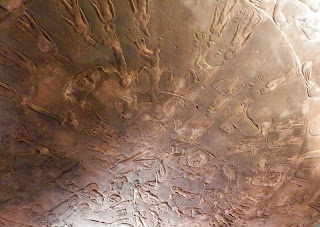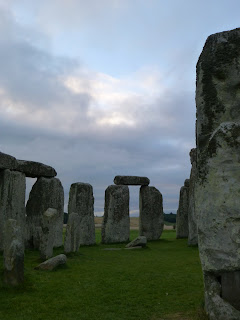St. John's Co-Cathedral in Valletta
St. John's Co-Cathedral in Valletta was a total surprise for me, and it wasn't even on our official tour! It was an add-on that was squeezed in at lunchtime. And it was breathtakingly opulent and amazing. Grandeur is the word!
It's a co-cathedral, as the Bishop's see was split between this cathedral and the one in Mdina.
The Knights of St. John created this cathedral as the seat of their order, their conventual (an order that permits the accumulation and possession of common property) church. And my, what a property it is!
The langues, the eight geographical/cultural groups within the order each designed a side chapel of the church, gifting it with gold, silver, remarkably beautiful artistry and paintings, relics, statuary and out-of-this-world beauty. The building was begun in 1572 and finished in 1577, but the decoration continued for decades. With each faction having their own room to decorate, some major contest of one-up-manship definitely took off.
Now, I haven't been to Rome, so I don't have papal palaces or cathedrals to compare, but St. John's Cathedral blew me away. It is fairly plain and non-descript on the outside, which probably was an asset during WWII bombing of Valletta, because it was unharmed while the city around it was largely decimated.
 On the inside the central sanctuary is flanked by eight rooms, each dedicated to a langue. The frescoes on the grand vaulted ceiling and around the walls are ingenious, designed and painted by the baroque artist Mattia Preti (1613 – 1699), They are a wonder of perspective and shadow art (the figures seem to be 3-dimensional because of the purposefully painted shadows over the architectural elements).
On the inside the central sanctuary is flanked by eight rooms, each dedicated to a langue. The frescoes on the grand vaulted ceiling and around the walls are ingenious, designed and painted by the baroque artist Mattia Preti (1613 – 1699), They are a wonder of perspective and shadow art (the figures seem to be 3-dimensional because of the purposefully painted shadows over the architectural elements).
 And then there's the floor! I could have spent hours looking at each one of the hundreds of tombs commemorating a knight or official associated with the order. There is a thin layer of inlaid marble with the most striking symbology of death I've ever seen assembled in one place. There are bones, skulls, coats of arms, swords, angels, castles and crowns! So many, in fact, that there is an interactive map of the floor layout, so you can click and receive information on one of the particular tombs out of the hundreds! I so wish I'd taken a decent picture of one!
And then there's the floor! I could have spent hours looking at each one of the hundreds of tombs commemorating a knight or official associated with the order. There is a thin layer of inlaid marble with the most striking symbology of death I've ever seen assembled in one place. There are bones, skulls, coats of arms, swords, angels, castles and crowns! So many, in fact, that there is an interactive map of the floor layout, so you can click and receive information on one of the particular tombs out of the hundreds! I so wish I'd taken a decent picture of one!
 The floor is fragile, the thin marble layer is protected by a special carpet so that people can walk around inside the building and not damage the floors. Once you're told what you're walking on, you wish they'd made you take off your shoes at the door! I don't know how they bear to place chairs on the floor, and I was happy to hear that they turn away tourists and islanders who choose to wear high heels--I can just imagine the potential damage a stilletto heel could do!
The floor is fragile, the thin marble layer is protected by a special carpet so that people can walk around inside the building and not damage the floors. Once you're told what you're walking on, you wish they'd made you take off your shoes at the door! I don't know how they bear to place chairs on the floor, and I was happy to hear that they turn away tourists and islanders who choose to wear high heels--I can just imagine the potential damage a stilletto heel could do!
 At the back of the bema, there is a gorgeous white marble statue of John the Baptist baptizing Jesus. Gold shines from every surface. Some of the gold, it was found during restoration in the Italian langue's wing, has been lightly covered in silver to enhance the shine! It's overload to look around--so many expressions of lavish design and artistic achievement!
At the back of the bema, there is a gorgeous white marble statue of John the Baptist baptizing Jesus. Gold shines from every surface. Some of the gold, it was found during restoration in the Italian langue's wing, has been lightly covered in silver to enhance the shine! It's overload to look around--so many expressions of lavish design and artistic achievement!

One corridor leads to a magnificent painting by Michelangelo Merisi da Caravaggio (1573-1610) of the Beheading of John the Baptist, done in the height of chiaroscuro style (dramatic use of shadow and dark and light to create a 3-D effect). Our guide, Joan, regaled us with tales of Caravaggio's sordid life and narrow escapes from justice. His art is on the grand scale, dark and brooding, and remarkably life-like. It's as if he captured John's last moment of consciousness.
As you walk around you become more and more amazed that such a jewel is not more widely known. There are priceless paintings, tapestries, altar items, and magnificent gifts from each of the langues to their mother church. Restoration efforts must be unceasing to keep it all in glowing condition. As I was there, there were people on scaffolding working on a section of the paintings.
It's a co-cathedral, as the Bishop's see was split between this cathedral and the one in Mdina.
The Knights of St. John created this cathedral as the seat of their order, their conventual (an order that permits the accumulation and possession of common property) church. And my, what a property it is!
The langues, the eight geographical/cultural groups within the order each designed a side chapel of the church, gifting it with gold, silver, remarkably beautiful artistry and paintings, relics, statuary and out-of-this-world beauty. The building was begun in 1572 and finished in 1577, but the decoration continued for decades. With each faction having their own room to decorate, some major contest of one-up-manship definitely took off.
 |
| The Italian chapel |
 On the inside the central sanctuary is flanked by eight rooms, each dedicated to a langue. The frescoes on the grand vaulted ceiling and around the walls are ingenious, designed and painted by the baroque artist Mattia Preti (1613 – 1699), They are a wonder of perspective and shadow art (the figures seem to be 3-dimensional because of the purposefully painted shadows over the architectural elements).
On the inside the central sanctuary is flanked by eight rooms, each dedicated to a langue. The frescoes on the grand vaulted ceiling and around the walls are ingenious, designed and painted by the baroque artist Mattia Preti (1613 – 1699), They are a wonder of perspective and shadow art (the figures seem to be 3-dimensional because of the purposefully painted shadows over the architectural elements). And then there's the floor! I could have spent hours looking at each one of the hundreds of tombs commemorating a knight or official associated with the order. There is a thin layer of inlaid marble with the most striking symbology of death I've ever seen assembled in one place. There are bones, skulls, coats of arms, swords, angels, castles and crowns! So many, in fact, that there is an interactive map of the floor layout, so you can click and receive information on one of the particular tombs out of the hundreds! I so wish I'd taken a decent picture of one!
And then there's the floor! I could have spent hours looking at each one of the hundreds of tombs commemorating a knight or official associated with the order. There is a thin layer of inlaid marble with the most striking symbology of death I've ever seen assembled in one place. There are bones, skulls, coats of arms, swords, angels, castles and crowns! So many, in fact, that there is an interactive map of the floor layout, so you can click and receive information on one of the particular tombs out of the hundreds! I so wish I'd taken a decent picture of one! The floor is fragile, the thin marble layer is protected by a special carpet so that people can walk around inside the building and not damage the floors. Once you're told what you're walking on, you wish they'd made you take off your shoes at the door! I don't know how they bear to place chairs on the floor, and I was happy to hear that they turn away tourists and islanders who choose to wear high heels--I can just imagine the potential damage a stilletto heel could do!
The floor is fragile, the thin marble layer is protected by a special carpet so that people can walk around inside the building and not damage the floors. Once you're told what you're walking on, you wish they'd made you take off your shoes at the door! I don't know how they bear to place chairs on the floor, and I was happy to hear that they turn away tourists and islanders who choose to wear high heels--I can just imagine the potential damage a stilletto heel could do! At the back of the bema, there is a gorgeous white marble statue of John the Baptist baptizing Jesus. Gold shines from every surface. Some of the gold, it was found during restoration in the Italian langue's wing, has been lightly covered in silver to enhance the shine! It's overload to look around--so many expressions of lavish design and artistic achievement!
At the back of the bema, there is a gorgeous white marble statue of John the Baptist baptizing Jesus. Gold shines from every surface. Some of the gold, it was found during restoration in the Italian langue's wing, has been lightly covered in silver to enhance the shine! It's overload to look around--so many expressions of lavish design and artistic achievement!
One corridor leads to a magnificent painting by Michelangelo Merisi da Caravaggio (1573-1610) of the Beheading of John the Baptist, done in the height of chiaroscuro style (dramatic use of shadow and dark and light to create a 3-D effect). Our guide, Joan, regaled us with tales of Caravaggio's sordid life and narrow escapes from justice. His art is on the grand scale, dark and brooding, and remarkably life-like. It's as if he captured John's last moment of consciousness.
As you walk around you become more and more amazed that such a jewel is not more widely known. There are priceless paintings, tapestries, altar items, and magnificent gifts from each of the langues to their mother church. Restoration efforts must be unceasing to keep it all in glowing condition. As I was there, there were people on scaffolding working on a section of the paintings.






Comments